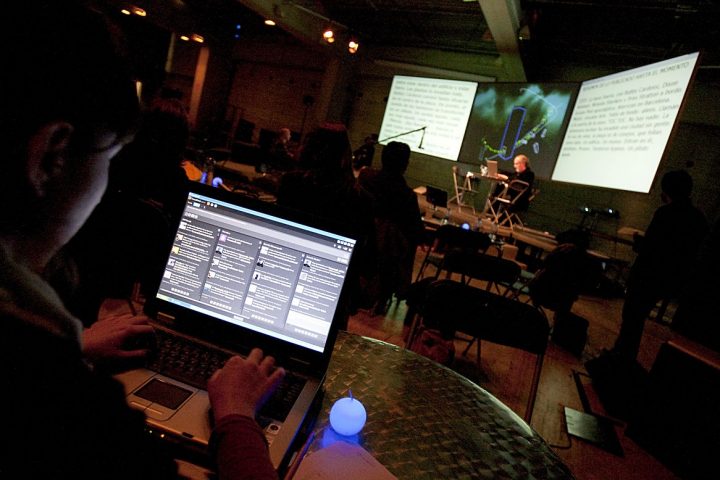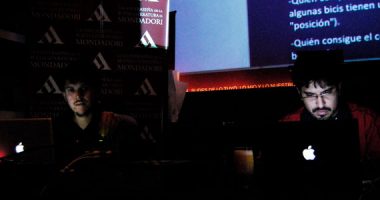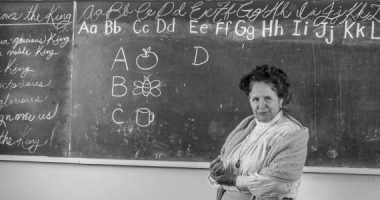
Kosmopolis. CCCB © Albert Uriach, 2011.
If we start from the assumption that today is more relevant to talk about “writing” than about “literature” because the first concept is inclusive and second much more limiting, we categorize some of the most interesting trends in Hispanic writing in the following categories: mimesis and reprocessing of new language technology, live writing, recovery of traditional formats, performance, collective and complex authorship, and sampling and remake. I briefly describe some of these trends and pose some Hispanic examples. It is not my intention to be exhaustive but give some clues from them because the interested reader can find his/her own interpretations and, above all, establish his/her own index lines of development of the current literature.
Mimesis and reprocessing of new language technology
In 2009, the publisher Penguin issued Twitterature compilation of summaries of great works of literature in twenty tweets or less. Last year, the Royal Shakespeare Company premiered Romeo and Juliet rewritten in 4000 tweets. This intervention is generally conceived as “story hacking” (Jay Bushman, for example, defined himself as “story hacker”and “theater Twitter producer” and has adapted Benito Centeno from Herman Melville). In this line, the Mexican group La Camara Verde made a public call to rewrite the story “Es que somos muy pobres,” by Juan Rulfo, in a series of not more than twenty messages of 140 characters. The instructions permitted everything: “all forms of re-writing: appropriation, recycling, copying, transcription, détournements, testing. The winner was published in the space La Camara Verde has at the Journal of Poetry at the UNAM.
Behind the initiative was the writer Cristina Rivera Garza, who published her next column in the culture section of the Mexican newspaper Milenio. The aphoristic limitation of Twitter or the search report that led to your own blog, therefore, are two of the ways that the Internet provides for research into new narrative strategies. Rivera Garza is one of the authors that are working with greater tenacity in the field of cyberliterature, in her blog No hay tal lugar. U-tópicos contemporáneos. The concept blogsívela is hers. And, among other lines of creation, one can find in her blog links to Las aventuras de la increíblemente pequeña, a lyrical fotonovel that investigates different ways of designing and writing, including power point.
Of course, plenty are the writers who are creating the narratives in the field of digital media and, therefore, reflect on these new types of structures and resources. Among others: Domenico Chiappe, Jaime Alejandro Rodríguez, Blas Valdez, Diego Bonilla, Antonio Rodriguez de las Heras and Belén Gache. In Alba Cromm(2010), Vicente Luis Mora worked in parallel in a narrative à la Cervantes and two blogs with the voice and the psychology of both characters. En Diario de las especies (2010), by Claudia Apablaza, and Las Teorias Salvajes (2008), by Pola Oloixarac, the network structure or the contents of a hard drive migrate to pages on paper. Incorporation is unstoppable, conscious or unconscious, information search, the concept of related forms of coexistence between text and image, embedded in literary textuality. It is unstoppable, judging by their importance in the projects of writers born in the 80s and 90s, personal web pages, blogs or profiles on social networking as works-in-progress: Willy Mackey from Venezuela or Spanish Luna Miguel.
Writing live
At the beginning of the last decade, Eugenio Tisselli scheduled Midpot, a software that manipulated text and image in real time using musical instruments or other interfaces. The results were projected on a screen. Live performance of the writer has spread within the Hispanic sphere over the past three years. To the classical tradition of the spoken word, performance and staging (the most common: the round table conference, the public interview, etc..), he added the transfer of the desktop and the computer in a public space, so that participants could read on a screen what the author is producing at the time. According to the coding of the writing jam driven by Adrian Haidukowski in Buenos Aires, the screen and keyboard are completed with the presence of a DJ who also plays live. This format, with multiple variations, has been exported successfully to Barcelona, Mexico City and Caracas. There are dozens of writers who have done this experiment, which falls within the context of current spectacle of the arts and professional practices. But it has a long series of precedents, especially for writers or artists associated with writing that led it to a study in an art gallery.
Recovery of artisan formats
The slow transition between paper books and e-books in the sphere of the global economic crisis is provoking reactions of (relative) rejection to technology and a (partial) return to craft. In Barcelona, the emergence of literary fanzines in recent months can be interpreted from these coordinates: Mapache Press, 5000 Negros. Un fanzine pulp, Huérfanos fanzine or El juguete rabiosoOther proposals in other locations, more professional (formally, literary or artistically), are Fuego Fanzine (contemporary art), Elefante Rosa Fanzine (experimental poetry), The Fanzine (with full version online: lafanzine.blogspot.com) , Vinalia (pulp), La lengua fanzine (poetry) and others.
Mario Bellatin latest project also falls under this scenario. Entitled Los cien mil libros de Mario Bellatin, is symbolic recovery of copyright on books he has written and published so far by traditional reprinting and distribution of these copies. Between literature and contemporary art, Bellatin has reconfigured his own shelves to house all the copies of the editions of his own work. The goal is to write and publish one hundred books in print runs of a thousand copies, which act as a thermometer or a countdown of his own life. And to recover the direct relation between the work itself and the readers. With a suitcase made for this purpose, that becomes a portable desktop, he goes around literary congresses always carrying copies of Los cien mil libros…, looking for readers who want to acquire them directly from the author. Each sale is therefore a performance.
Performance
At the beginning of the century, the economic crisis that hit Argentina caused, directly or indirectly, the need to find new relationships between producers and recipients of culture. Along with the popularization of performances of young poets, which carried out the direct sale of books, or the birth of the writing jam (sponsored by Random House), other phenomena must be observed that relates literature and theater and performance. From drama Vivi Tellas began in 1995 to work on the intersections between different spaces and art in the project Museos (works that come from contact between dramatic centers and museum directors), and gave birth last decade to the concept of Biodrama on the basis that all human beings have a story to tell. In 2003, the project Documentales en Vivo, through the idea of creating a theater at Umbral Mínimo de Ficción began a line of work that led to collaborations with the writer Edgardo Cozarinsky, such as Cozarinsky y su médico The author worked closely with a renowned theater director to explain a scenario, the experience of overcoming a serious illness live. The author, beyond the traditional script of a play or a screenplay, becomes autobiographical actor, a performer of non-fiction. In Spain, Sonia Gomez (with shows like Mi madre y yo ’04) and Ignacio Duarte (with his concept of “theater machine” that channeled through direct conversations with writers) would be akin to examples of work produced by Tellas in Argentina. Performative writers constitute a major trend nowadays. Mexican Mario Bellatin Mexican, Argentinean Gabriela Bejerman and Washington Cucurto, the Peruvians Gabriela Wiener and Jaime Rodriguez Z. or Spaniards Javier Calvo, El Cangrejo Pistolero, Agustín Fernández Mallo and Eloy Fernández Porta are some Hispanic writers today who are working in parallel to their written reports, in staging shows. The trend itself is not new, but its proliferation and especially its apparent politicization seems to be. During the 80s and 90s, the Chilean authors Diamela Eltit, Raul Zurita and Pedro Lemebel, for example, link their performance practices with condemnation of institutional violence. In the post-postmodern context, however, the protest is not an obvious priority, such as other spectacular examples.
Collective and complex authorship
The undeniable spectacularity of two online projects is the one of collective Hotel Postmoderno. The first was the digital storytelling Suicídame (2010), which was followed the next year for “live fan fiction creation” or the Spanish and Argentinian “reality show” Los siete vampiros. Before these incursions into the digital world, the Hotel Postmoderno collective published two books, Hotel Postmoderno (2008) and De la Havana un barco (2010). The structure that supports these projects is the open network. This is not a closed artistic collective, but a variable number of writers, working with actors, musicians, graphic designers, computer programmers, etc.. The hypernovel is paying off interest. As an example, the pioneering story of anticipation Condiciones Extremas (1998), written by John B. Gutierrez, Alberto Rodriguez, Peña and Tamara Castro Giovanni, with four hundred links that ensure multiple routes of reading. The complexity of authorship is even greater when we enter the field of ergodic literature: authorship is not only multiple, but also not controlled. As with WikiAventura, an open and unpredictable story, written in second person and, therefore, it is addressed directly to a reader that in order for the story to progress, the reader must at some point be involved, keep creating.
Sampling and remake
Hispano-Peruvian writer Fernando Iwasaki is the author of a microstory entitled “Remake” and another titled “Caperucita reloaded”. Agustín Fernández Mallo published in 2011 El hacedor (Borges), remake. Such operations that have many precedents in the history of literature, have spread in recent years, using post-conceptual twists, and have also led to a series of bestsellers built by the expansion of classical works. From the successful Pride and Prejudice and Zombies, the result of an intervention by Seth Grahame-Smith in the original piece by Jane Austen, to Android Karenina, Robin Hood and Friar Tuck: Zombie Killers or Romeo & Juliet & Vampires, among many other titles. Far from the commercial intention and closer to conceptual art, the Argentine writer Paul Katchadjian published in 2009 El Aleph engordado, an expansion of Borges’ original story (before he had carried out another remake, El Martín Fierro ordenado alfabéticamente, a exercise without rewriting, through the option of having an alphabetical order in Word, with a poetic brilliant result, following the school of combinatory poetry and without human intervention, such as that conducted by Eugenio Tisselli).
Marina Zerbarini has reworked two stories by Joyce with Eveline, fragmentos de una respuesta. Many of these works are disseminated through personal blogs, websites and journals, or in limited editions, which are often handmade, or magazines interested in literary experimentation, such as Quimera or Bostezo. In the last issue of Bostezo one can find “Snuff sampler”, where Eloy Fernandez Porta becomes coach, translator and assemblier, and creates a scene from ten literary fragments (of works by Juan Francisco Ferré, RM Barry, Vicente Munoz Alvarez, Hubert Selby, Violeta C. Rangel, Miguel de Palol, Dennis Cooper, Bret Easton Ellis, Benjamin Weissman and the author himself).






Ferran Cerdans Serra | 31 May 2011
Hola! M’agradaria afegir a http://www.llibres-artesans.com a aquesta llista, ja que participa tant de la literatura en directe com dels formats artesans. L’escriptura en directe a “llibres lliures artesans” és online en temps real i es pot seguir des del navegador en sessions concertades, mentre que els formats artesans són les sèries de llibres enquadernats a mà per l’autor, i en alguns casos escrits a mà poema a poema pel mateix, que publiquem des de fa 9 anys. Des de l’inici del projecte les obres han estat escrites en obert (es poden llegir a la web segons es van publicant) i al mateix temps editades i publicades de manera artesanal. El nostre lema és “fem els llibres del futur”, i no perquè soni bé sinó perquè pensem que els llibres amb més futur són les edicions artesanals. Això no impedeix l’experimentació en nous formats digitals, ans al contrari, les tecnologies són per a explorar i descobrir fins on ens poden dur.
Felicitats per l’article recopilatori, de cop i volta tinc un munt de feina de recerca per a posar-me al dia d’aquests autors i projectes, salut!
Leave a comment